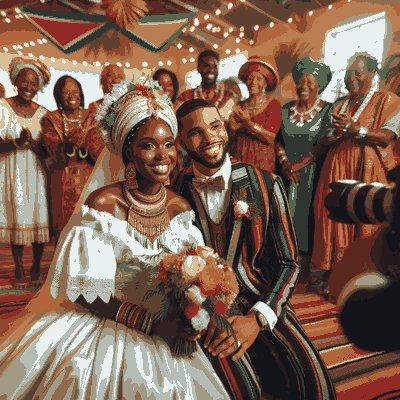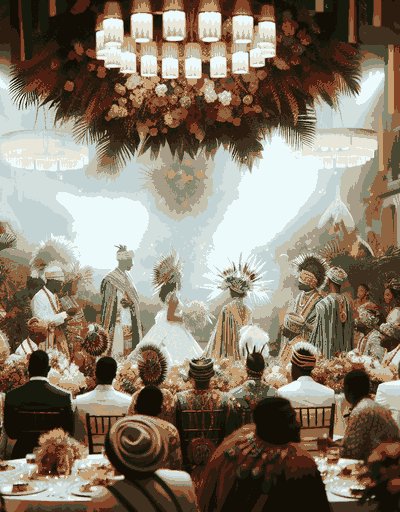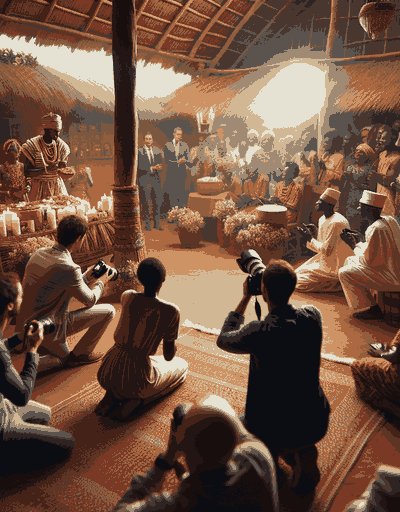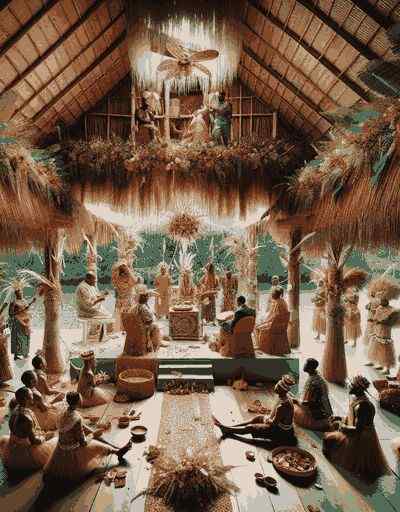Guyana Wedding Traditions Complete Guide for Modern Couples
Guyanese wedding traditions are multicultural marriage celebrations that blend Hindu, Muslim, Christian, and Afro-Guyanese customs, typically lasting 2-7 days and involving 200-500 guests. These traditions encompass pre-wedding ceremonies like MatikorMAH-tee-kor and Mehendimeh-HEN-dee, religious ceremonies including Vivahvee-VAH and Nikahnee-KAH, and modern fusion celebrations, creating distinctive matrimonial customs that reflect Guyana’s six major ethnic groups.

Overview of Guyanese Wedding Process

- Pre-wedding ceremonies: 2-5 days before wedding
- Main ceremony day: Religious rituals (3-6 hours)
- Post-wedding celebrations: 1-2 days after ceremony
- Total participants: 200-500 guests typical
- Average cost: $10,000-$50,000 USD
- Planning timeline: 6-12 months in advance
1. Historical and Cultural Context

What Are the Multicultural Roots of Guyanese Weddings?
Guyanese wedding customs originated from the convergence of six major ethnic groups: Indo-Guyanese (40%), Afro-Guyanese (29%), Mixed (20%), Amerindian (10%), Chinese (0.5%), and European (0.5%). These diverse wedding traditions began forming in the 1830s with the arrival of indentured laborers from India, who brought Hindu and Muslim marriage customs that blended with existing African, Indigenous, and European Christian practices.
The colonial era (1814-1966) saw European missionaries introduce Christian wedding ceremonies, while the post-indenture period (1917-1940s) witnessed the preservation and adaptation of Indian wedding traditions. Today, 85% of Guyanese weddings incorporate elements from multiple cultural traditions, creating uniquely hybrid celebrations.
Regional Variations in Wedding Practices
Coastal wedding traditions (Georgetown, New Amsterdam) feature more Western influences and typically cost $15,000-$50,000 USD, with 300-500 guests attending. These urban celebrations often include:
- Professional wedding planners and venues
- Fusion cuisine combining all ethnic traditions
- Modern sound systems and DJ services
- Photography packages ($2,000-$5,000 USD)
Interior region weddings (Rupununi, Bartica) maintain stronger traditional elements and cost $5,000-$15,000 USD, with 100-200 guests. Rural celebrations emphasize:
- Community-prepared traditional foods
- Extended ceremonial timeframes (5-7 days)
- Greater involvement of elders in rituals
- Traditional music and instruments
Modern Cultural Fusion Trends
Contemporary Guyanese couples blend traditions across religious lines in 75% of weddings surveyed. Common fusion elements include:
- Hindu couples incorporating Christian reception styles
- Muslim weddings adding Hindu haldiHULL-deeturmeric ceremonies
- Christian ceremonies including Indo-Guyanese dye-rubbing
- Afro-Guyanese weddings featuring Indian cuisine
2. Hindu Guyanese Wedding Traditions and Ceremonies

Pre-Wedding Ceremonies Timeline
Hindu Guyanese weddings involve elaborate pre-wedding events spanning 3-5 days before the main ceremony. The complete timeline includes:
7 days before: Family consultations and preparation begins 5 days before: House cleaning and decoration rituals 3 days before: MatikorMAH-tee-kor ceremony (evening event) 2 days before: HaldiHULL-dee/Saffron ceremony (morning) 1 day before: Mehendimeh-HEN-dee ceremony (afternoon/evening) Wedding day: Vivahvee-VAH ceremony (4-6 hours)
What Is the Matikor/Maticore Ceremony?
Matikor (also called MaticoreMAH-tee-kor or Matikore) is a female-centered Hindu pre-wedding ritual where 50-100 women gather to honor Mother Earth and prepare the bride for marriage through songs, dance, and fertility rituals involving sacred soil. This centuries-old tradition, brought by Indian indentured laborers in the 1840s, takes place 3 nights before the wedding and costs approximately $500-$1,500 USD to host.
The ceremony process involves:
- Soil collection: Women gather earth from fertile ground near water
- Procession: Female relatives carry the soil to the wedding house
- Puja performance: Bride performs worship with the sacred earth
- Songs and instruction: Married women share marriage wisdom
- Feast: Traditional vegetarian dishes served to all attendees
Regional variations include:
- Berbice Matikor: Features specific folk songs in Bhojpuri
- Essequibo tradition: Includes coconut-breaking rituals
- Georgetown style: Often condensed to 2-3 hours
- Rural variations: May extend past midnight with all-night singing
Haldi/Saffron Ceremony Details
Haldi ceremony is the application of turmeric paste (haldi) to purify and beautify the bride and groom 2 days before the wedding, involving 30-50 family members and costing $200-$500 USD. This 2-hour ritual originated in ancient India where turmeric’s antiseptic properties were valued for skin preparation.
The paste ingredients include:
- Turmeric powder (2 cups)
- Sandalwood powder (1/2 cup)
- Rose water or milk
- Essential oils (optional)
- Fresh herbs (neemneem, tulsiTOOL-see)
Application process:
- Preparation: Elder women mix the paste while singing
- Blessing: Paste blessed by married women
- Application: Applied to face, neck, arms, and feet
- Duration: Paste remains for 30-60 minutes
- Cleansing: Removed with milk or rose water
Mehendi Ceremony Traditions
Mehendi (meh-HEN-dee) is the intricate henna application ceremony where professional artists create elaborate designs on the bride’s hands and feet, typically costing $300-$800 USD and lasting 4-6 hours. This tradition, dating back 5,000 years to ancient India, involves 30-75 female guests who celebrate while the bride receives her henna designs.
Modern mehendi features include:
- Personalized design elements (couple’s initials, wedding date)
- Professional artists charging $150-$500 USD
- Photography sessions during application
- Games and entertainment for guests
- Traditional snacks and sweets served
Design symbolism:
- Peacocks: Beauty and grace
- Lotus flowers: Purity and enlightenment
- Paisley patterns: Fertility and luck
- Mandala designs: Unity and harmony
- Groom’s initials: Hidden within patterns
3. The Hindu Wedding Ceremony (Vivah)
What Happens During a Vivah Ceremony?
Vivahvee-VAH (vee-VAH) is the Hindu wedding ceremony performed within a decorated mandapMAN-dapMAN-dap, lasting 3-4 hours and conducted by a panditPUN-dit who guides the couple through seven sacred rituals around a holy fire. The ceremony costs $2,000-$5,000 USD including priest fees, decorations, and ritual materials, with 150-300 guests typically attending.
Essential ceremony components:
- Mandap setup: $500-$2,000 USD for flowers and decorations
- Sacred fire materials: $100-$200 USD
- Priest (pandit) fees: $500-$1,500 USD
- Ritual items: $200-$500 USD
- Traditional music: $300-$800 USD
Key Vivah Rituals Explained
Kanyadaankan-yaa-DAAN (kan-yaa-DAAN) is the ritual where the bride’s father places his daughter’s hand in the groom’s, symbolically transferring responsibility for her care and protection. This emotional ceremony takes 10-15 minutes and represents one of Hinduism’s highest forms of charity (daan).
Mangal Pheramun-gul FAIR-ah/Saptapadisap-tah-PAH-dee involves the couple taking seven steps around the sacred fire (agniUG-nee), with each step representing a specific marital vow:
- First step: Nourishment and food
- Second step: Strength and health
- Third step: Prosperity and wealth
- Fourth step: Happiness and family
- Fifth step: Children and continuity
- Sixth step: Seasons and longevity
- Seventh step: Friendship and loyalty
Jai Malajay MAH-lah (jay MAH-lah) is the exchange of flower garlands costing $50-$150 USD, where the bride and groom place marigold or rose garlands around each other’s necks three times. This 5-minute ritual signifies mutual acceptance and respect between the couple.
Sindoorsin-DOOR Application marks the ceremony’s conclusion when the groom applies red vermillion powder (sindoor) to the bride’s hair parting, transforming her status to a married woman. The sindoor costs $10-$20 USD and will be applied daily throughout married life.
4. Post-Wedding Hindu Traditions
What Is the Kangan Ceremony?
Kangankan-GAN ceremony (kan-GAN) is the final Hindu wedding event where the bride’s family presents the newlyweds with gold bangles worth $500-$2,000 USD, symbolizing prosperity and welcoming them as a married couple. This 2-3 hour celebration occurs 1-2 days after the wedding and involves 50-100 close family members.
The ceremony includes:
- Bangle presentation: 7-21 gold bangles gifted
- Blessing rituals: Elders offer prayers and advice
- Traditional sweets: Mithaimih-TIE, ladooluh-DOO, jalebijuh-LAY-bee served
- Gift exchange: Additional jewelry and household items
- Feast: Vegetarian meal for all attendees
Regional Kangan variations:
- Berbice tradition: Silver anklets also presented
- West Coast custom: Includes sari gifting to bride
- Georgetown style: Often combined with reception
- Rural practice: Extended family stays overnight
5. Muslim Guyanese Wedding Traditions
The Nikah Ceremony Process
Nikahnee-KAH (nee-KAH) is the Islamic marriage contract ceremony conducted by an Imamih-MAHM, lasting 30-60 minutes and requiring the presence of at least two witnesses per Islamic law. The ceremony costs $500-$2,000 USD including venue, Imam fees, and documentation, with 50-200 guests typically attending.
Essential Nikah elements:
- MahrMAH-her (dower): $1,000-$10,000 USD agreed upon
- Nikah namanee-KAH NAH-mah: Marriage contract documentation
- Imam fees: $200-$500 USD
- Venue rental: $300-$1,000 USD (if not at mosque)
- Quranic recitation: 15-20 minutes
The ceremony sequence:
- Opening prayers: Imam recites Quranic verses
- Consent verification: Both parties asked separately
- Contract signing: Witnessed by two Muslim males
- “Qabulkah-BOOL” declaration: Each party states acceptance thrice
- Sweet sharing: Couple shares dates or honey
- Closing prayers: Blessings for the marriage
Muslim Wedding Variations by Region
Coastal Muslim weddings incorporate more Indo-Guyanese elements, with 60% including haldiHULL-dee ceremonies and 40% featuring mehendimeh-HEN-dee application. These celebrations cost $10,000-$30,000 USD and blend Islamic requirements with cultural traditions.
Interior Muslim ceremonies maintain stricter Islamic traditions, focusing on:
- Segregated celebration spaces
- Traditional Islamic attire only
- Arabic prayer emphasis
- Simpler decoration styles
- Lower costs ($5,000-$15,000 USD)
6. Christian Guyanese Wedding Traditions
Christian Ceremony Distinctions
Christian wedding ceremonies in Guyana follow denominational traditions while incorporating local customs, lasting 45-90 minutes and costing $3,000-$15,000 USD including church fees, decorations, and reception. These ceremonies accommodate 150-400 guests across various denominations.
Denominational differences:
- Catholic ceremonies: Include mass (additional 30 minutes)
- Anglican services: Follow 1662 Prayer Book format
- Methodist weddings: Feature unity candle lighting
- Pentecostal celebrations: Include praise and worship segment
- Presbyterian rites: Emphasize covenant vows
Unique Christian Wedding Elements
Virgin Mary shrine tradition in Catholic weddings involves brides placing bouquets worth $50-$100 USD at Mary’s altar, seeking blessing for motherhood. This 5-minute ritual occurs after the main ceremony in 70% of Catholic weddings.
Unity candle ceremony costs $30-$50 USD for special candles and represents two lives becoming one. The ritual sequence:
- Mothers light taper candles
- Couple takes lit tapers
- Together light central candle
- Taper candles extinguished
- Unity candle remains lit
Car procession tradition features 20-50 decorated vehicles with horns honking and hazard lights flashing, creating a celebratory parade from church to reception venue. This 30-minute procession costs $200-$500 USD for decorations and coordination.
7. Afro-Guyanese Wedding Traditions
What Is the Kwekwe Ceremony?
KwekweKWAY-kway (KWAY-kway) is a traditional Afro-Guyanese pre-wedding celebration where 75-150 women gather at the bride’s home the night before the wedding for singing, dancing, and marriage preparation rituals. This 4-6 hour event costs $500-$1,500 USD and preserves African cultural heritage passed down through generations since the 1800s.
Kwekwe activities include:
- Traditional songs: Folk melodies in Creole
- Ring dance: Circular dances around the bride
- Marriage counseling: Elder women share wisdom
- Symbolic rituals: Broom jumping preparation
- Community feast: Cook-up rice, cassava bread
Afro-Guyanese Wedding Celebrations
Afro-Guyanese Christian weddings feature the largest bridal parties in Guyana, with 8-14 pairs of attendants costing $2,000-$5,000 USD for coordination and attire. These elaborate ceremonies reflect West African traditions of community involvement.
Reception elements:
- Guest count: 300-500 attendees typical
- Music: Steel pan, calypso, soca performances
- Dance: Traditional African and Caribbean styles
- Food service: Buffet-style Creole cuisine
- Duration: 6-8 hours of celebration
8. Cross-Cultural Wedding Adoptions
How Traditions Cross Religious Boundaries
Cultural fusion in Guyanese weddings occurs in 85% of modern ceremonies, with couples borrowing traditions across religious lines to create unique celebrations. This blending began in the 1960s post-independence era and now represents mainstream practice.
Common cross-cultural adoptions:
- HaldiHULL-dee in Christian weddings: 40% now include turmeric ceremonies
- White gowns in Hindu ceremonies: 60% of brides wear Western dress
- Receptions in Muslim weddings: 70% host dance receptions
- Mehendimeh-HEN-dee for all brides: 50% of non-Hindu brides apply henna
- Multi-faith blessings: 30% include prayers from multiple religions
Modern Fusion Wedding Costs
Fusion weddings combining multiple traditions cost 20-40% more than single-tradition ceremonies:
- Hindu-Christian fusion: $25,000-$40,000 USD average
- Muslim-Hindu blend: $20,000-$35,000 USD typical
- Full multicultural: $30,000-$50,000 USD common
- Simplified fusion: $15,000-$25,000 USD minimum
9. Wedding Attire and Fashion
Traditional Bridal Clothing by Culture
Hindu bridal attire features red or maroon sarees costing $500-$3,000 USD or lehengas (leh-HEN-gah) priced $800-$5,000 USD, with 22-karat gold jewelry sets valued at $3,000-$15,000 USD. Modern brides often have 2-3 outfit changes during celebrations.
Muslim wedding attire emphasizes modest, embellished outfits in jewel tones costing $600-$2,500 USD, with:
- Shararashah-RAH-rah sets: Wide-legged pants with long tops
- Anarkaliah-nar-KAH-lee suits: Floor-length fitted dresses
- Hijab styles: Decorated with crystals or embroidery
- Gold jewelry: More delicate than Hindu styles
Christian wedding gowns range from $800-$5,000 USD with 70% choosing white or ivory, while 30% incorporate cultural elements through:
- Sari-inspired draping: On Western silhouettes
- Embroidered details: Using Indian motifs
- Color accents: Gold or red embellishments
- Traditional jewelry: Mixed with Western accessories
Groom’s Wedding Attire
Traditional groom’s clothing varies by culture with costs ranging $300-$1,500 USD:
- Hindu grooms: Sherwanisher-WAH-nee or dhoti-kurta sets
- Muslim grooms: Embroidered kurta-pajamas
- Christian grooms: Tuxedos or formal suits
- Fusion options: Nehru jackets over Western suits
10. Wedding Food and Cuisine
Traditional Wedding Feast Menus
Indo-Guyanese wedding menus serve 200-500 guests at $15-$30 USD per person, featuring:
- Meat curries: Chicken, goat, duck ($5-$8/serving)
- Vegetarian options: Dhaldahl, channaCHUN-nah, bajiBAH-jee
- Rice dishes: Biryanibir-YAH-nee, plain rice, fried rice
- Breads: RotiROH-tee, puriPOO-ree, naannahn$1-$2/piece
- Desserts: Gulab jamungoo-LAB jah-MOON, kheerkheer, mithaimih-TIE
- Beverages: MaubyMAW-bee, sorrelSOR-rel, rum punch
Afro-Guyanese cuisine costs $20-$35 USD per guest including:
- Main dishes: PepperpotPEP-per-pot, cook-up rice, metemgeemeh-tem-GEE
- Proteins: Fried fish, jerk chicken, curry goat
- Sides: Plantains, cassava, breadfruit
- Desserts: Black cake, cassava ponekah-SAH-vah pohn, salarasah-LAH-rah
- Drinks: Ginger beer, lime wash, rum cocktails
Modern Catering Trends
Contemporary wedding catering incorporates:
- Fusion menus: Combining all ethnic cuisines
- Dietary options: Halal, vegetarian, vegan choices
- Live stations: Roti-making, cocktail mixing
- International options: Pizza, pasta for younger guests
- Dessert tables: Mix of traditional and modern sweets
11. Contemporary Wedding Trends
Destination Wedding Options
Las Vegas wedding packages offer Guyanese couples simplified alternatives to traditional multi-day celebrations, with costs ranging from $159 USD for basic chapel ceremonies to $14,999 USD for full reception packages accommodating 225 guests.
Popular Vegas package tiers:
- Chapel ceremonies: $159-$500 USD (12 guests max)
- Garden weddings: $399-$999 USD (20-30 guests)
- Bronze packages: $2,199 USD (30 guests, basic reception)
- Silver packages: $5,999 USD (50 guests, enhanced menu)
- Gold packages: $9,999 USD (75 guests, premium options)
- Platinum packages: $14,999 USD (100+ guests, luxury service)
Technology in Modern Weddings
Digital integration costs $500-$3,000 USD and includes:
- Live streaming: For overseas relatives ($300-$800)
- Wedding websites: Custom designs ($200-$500)
- Social media: Hashtags and photo sharing
- Digital invitations: Saving $300-$1,000 on printing
- Drone photography: Aerial venue shots ($500-$1,500)
12. Complete Wedding Timeline and Costs
Traditional Guyanese Wedding Budget Breakdown
Average total wedding cost: $15,000-$35,000 USD for 200-400 guests
Major expense categories:
- Venue and catering: 40-50% of budget
- Clothing and jewelry: 20-25% of budget
- Photography/videography: 10-15% of budget
- Decorations: 10-12% of budget
- Religious ceremonies: 5-8% of budget
- Entertainment: 5-8% of budget
- Miscellaneous: 5-10% of budget
12-Month Planning Timeline
12 months before: Set budget, choose dates, book venue 10 months before: Hire vendors, order attire 8 months before: Send save-the-dates, plan ceremonies 6 months before: Finalize guest list, order invitations 4 months before: Menu tasting, ceremony rehearsals 2 months before: Final fittings, confirm vendors 1 month before: Obtain marriage license, final payments 1 week before: Pre-wedding ceremonies begin
13. Regional Wedding Traditions Map
Georgetown (Capital) Wedding Characteristics
- Average cost: $20,000-$50,000 USD
- Guest count: 300-500 typical
- Venue options: Hotels, convention centers
- Cultural mix: All traditions represented
- Modern amenities: Full vendor services
Berbice Region Traditions
- Average cost: $10,000-$25,000 USD
- Guest count: 200-350 common
- Venue style: Community centers, temples
- Dominant culture: Indo-Guyanese (65%)
- Traditional emphasis: Longer ceremonies
Essequibo Coast Customs
- Average cost: $8,000-$20,000 USD
- Guest count: 150-300 typical
- Venue preference: Family compounds
- Cultural blend: Mixed traditions
- Community involvement: High participation
Interior/Rupununi Practices
- Average cost: $5,000-$15,000 USD
- Guest count: 100-200 average
- Venue type: Village centers, outdoors
- Indigenous influence: 30% incorporate Amerindian customs
- Duration: Extended 5-7 day celebrations
How much does a typical Guyanese wedding cost?
Traditional Guyanese weddings cost between $15,000-$35,000 USD for 200-400 guests, with Hindu ceremonies typically being the most expensive due to multiple events over 3-5 days. Budget-conscious couples can reduce costs to $8,000-$12,000 USD by limiting guest lists and simplifying ceremonies, while elaborate celebrations in Georgetown can exceed $50,000 USD.
How long do Guyanese wedding celebrations last?
Hindu weddings traditionally span 3-5 days including pre-wedding ceremonies like MatikorMAH-tee-kor and post-wedding Kangankan-GAN. Muslim and Christian weddings typically last 1-2 days, while Afro-Guyanese celebrations may extend to 3 days with the KwekweKWAY-kway ceremony. Modern fusion weddings average 2-3 days of events.
Can non-religious couples have a traditional Guyanese wedding?
Yes, many non-religious Guyanese couples incorporate cultural traditions without religious ceremonies. Popular choices include mehendimeh-HEN-dee application, haldiHULL-dee ceremonies, traditional attire, and cultural music and food. Civil ceremonies can be enhanced with these cultural elements while avoiding religious rituals.
What’s the difference between Matikor and Kwekwe ceremonies?
Matikor is a Hindu pre-wedding ceremony focused on honoring Mother Earth and preparing the bride through soil rituals and female bonding. Kwekwe is an Afro-Guyanese tradition emphasizing African heritage through songs, dances, and community celebration. Both are female-centered events but have different cultural origins and practices.
Do all Guyanese brides wear red sarees?
While red sarees are traditional for Hindu brides (worn by about 70%), modern Guyanese brides often have multiple outfit changes. Many now wear white gowns for receptions regardless of religion, and Muslim brides typically choose jewel-toned outfits. Christian brides primarily wear white throughout their ceremonies.
What food is served at Guyanese weddings?
Guyanese wedding menus typically feature curry dishes (chicken, goat, duck), rotiROH-tee, rice dishes, and traditional desserts. Indo-Guyanese weddings emphasize Indian-influenced cuisine, while Afro-Guyanese celebrations include dishes like pepperpotPEP-per-pot and cook-up rice. Most modern weddings offer fusion menus combining all ethnic cuisines.
How far in advance should we plan a Guyanese wedding?
Traditional Guyanese weddings require 6-12 months of planning, with 9 months being ideal. This allows time for booking venues, ordering custom attire from overseas, coordinating multiple ceremonies, and arranging travel for international guests. Simplified weddings can be planned in 3-6 months.
Are destination weddings popular among Guyanese couples?
Yes, approximately 15-20% of Guyanese couples now choose destination weddings, with Las Vegas being the most popular choice. These packages range from $159 for simple ceremonies to $14,999 for full receptions, offering significant savings compared to traditional multi-day Guyanese celebrations.
What’s the significance of the seven steps in Hindu weddings?
The Saptapadisap-tah-PAH-dee or seven steps around the sacred fire represent seven marital vows: nourishment, strength, prosperity, happiness, progeny, longevity, and eternal friendship. Each step is considered sacred and binding, making the marriage official in Hindu tradition once completed.
Can we mix traditions from different Guyanese cultures?
Yes, cultural fusion is common in 85% of modern Guyanese weddings. Couples successfully blend elements like Hindu haldi ceremonies with Christian receptions, or incorporate Muslim mehendi with Afro-Guyanese music. The key is respecting the significance of each tradition while creating a personalized celebration.
Frequently Asked Questions
What is the Cook Night (Matikor) ceremony in Guyanese weddings?
Cook Night is a women-only pre-wedding celebration where female relatives prepare traditional dishes, sing wedding songs, and apply mehendi (henna) on the bride. It's an important bonding ritual that typically occurs a few days before the wedding.
What is the traditional wedding feast in Guyana?
The traditional Guyanese wedding feast typically includes seven curry, pepperpot, cook-up rice, and black cake. The 'seven curry' is particularly significant and must include seven different types of curry dishes.
How long do traditional Guyanese weddings last?
Traditional Guyanese weddings can last anywhere from 1-3 days, with various ceremonies and celebrations occurring on different days. Rural weddings tend to last longer than urban ones.
What is the significance of 'cleaning down' before a Guyanese wedding?
The 'cleaning down' tradition involves thoroughly cleaning and decorating the home before the wedding. It symbolizes a fresh start for the couple and welcomes good fortune into their new life together.
What type of music is played at Guyanese weddings?
Guyanese weddings feature a diverse mix of music including tassa drumming, chutney music, African drums, folk songs, and modern Caribbean music. Each style represents different cultural influences in Guyana.
What are common wedding gifts in Guyana?
Common wedding gifts include money, household items, gold jewelry, traditional crafts, and sometimes land or property from parents. Modern couples may also use wedding registries.
What is the traditional bridal attire in Guyana?
Guyanese brides often wear elaborate saris or lehengas for Hindu ceremonies, while Western-style white gowns are common in Christian ceremonies. The choice often reflects the bride's cultural background.
How are Muslim weddings (Nikah) celebrated in Guyana?
Muslim weddings in Guyana include Quranic readings and typically feature separate celebrations for men and women. The Nikah ceremony is performed by an Imam with witnesses present.
What role do families play in Guyanese weddings?
Families play a central role in Guyanese weddings, from arranging marriages to organizing ceremonies. The 'asking for the hand' ceremony involves formal negotiations between families.
How are modern Guyanese weddings different from traditional ones?
Modern Guyanese weddings often incorporate contemporary elements like professional planning, social media sharing, and destination venues while maintaining core traditional customs and rituals.